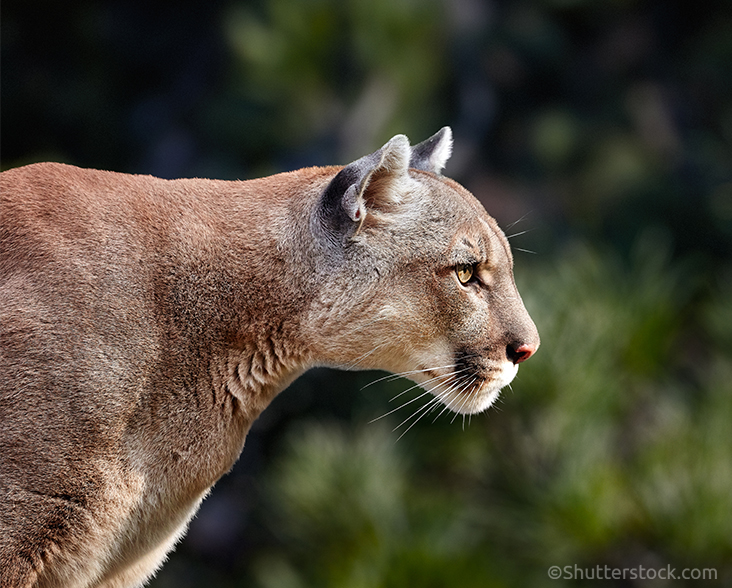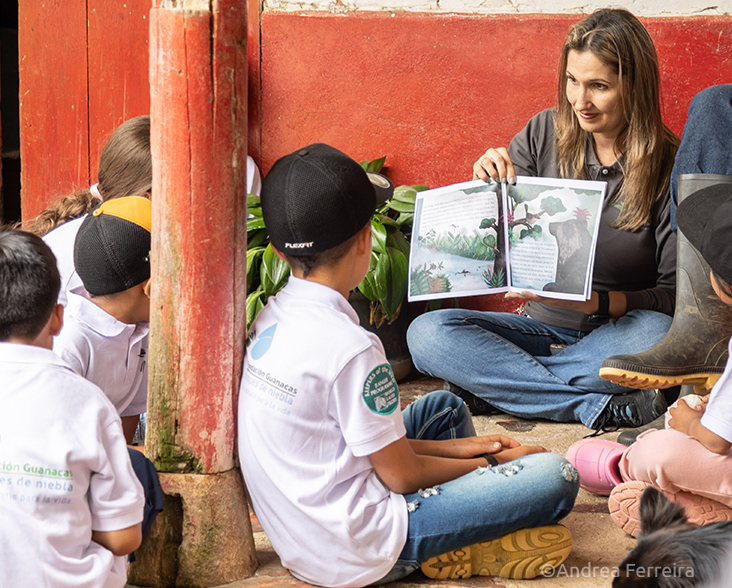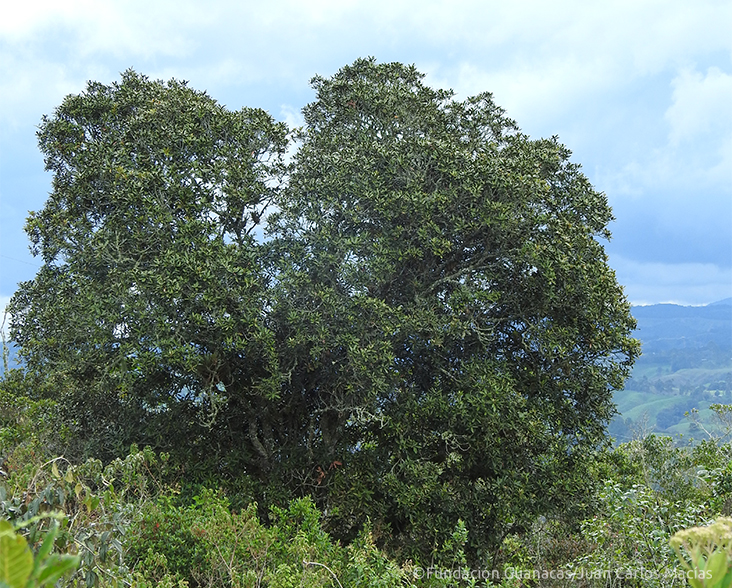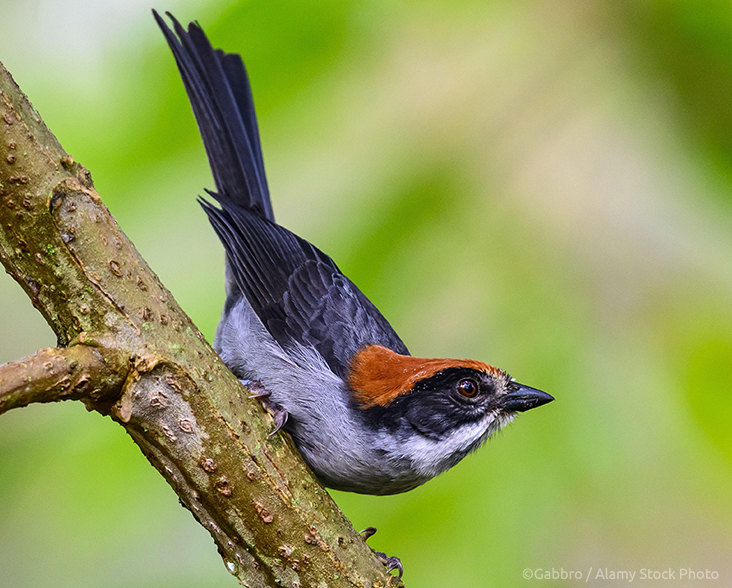



Thank You!
Thanks to your support and generous donations, we’re delighted to announce that our Colombia’s Forests of Mist appeal has reached its £1.15 million target. Our partner Fundación Guanacas can now expand and protect the remarkable cloud forests of the Guanacas Reserve.
Fundación Guanacas needs your help to secure a future for one of
Colombia’s threatened cloud forests.
These forests are disappearing. Colombia, a country with some of the largest cloud forest areas in Latin America, has only 10–20% of its original cloud forests remaining. We cannot afford to allow the disappearance of these globally important forests. They need urgent protection and restoration now. Donate today and your support will:
• Extend the protected area of land by 181 hectares, leading to the total protection of 1,031 hectares •
• Restore 100 hectares of vital cloud forest habitat by planting 36,500 native tree species between 2023 and 2028 •
• Protect the habitat of 665 species, including 15 species on the IUCN Red List •
• Ensure the health and security of precious water cycles on which wildlife and local human populations depend •
• Offer alternative livelihoods to local communities through ecotourism and conservation jobs •
Together, we can make this happen by reaching our target of £1,150,000, which will enable WLT-partner Fundación Guanacas to expand its Guanacas Reserve.
The reserve contains one of Colombia’s only cloud forests in its Antioquia region. Our partner is in need of funds to save land that would otherwise be vulnerable to further deforestation and soil degradation.
Cloud forests in the Tropical Andes Biodiversity Hotspot are vulnerable to climate change, as warming temperatures is leading to strong shifts in the range of species, population declines, and local extinctions.
With your support, this appeal will restore and increase protection for one of the few remaining cloud forests in Colombia’s Antioquia region. Reaching heights of between 1,900 and 2,700 metres above sea level, the cloud forest within the Guanacas Reserve boasts an extraordinary concentration of species within a very small geographical range. Its lofty altitudes, elevation, and humidity has led to a habitat for many species adapted to this particular region. Several of these species are threatened, including the Antioquia Brushfinch (Atlapetes blancae, a bird once thought extinct), the Antioquia Chocolate Frog (Hyloscirtus antioquia), and Puma (Puma concolor).
Carpeting the forest floor and coating tree branches are fungi, mosses, and lichen – indicators of their damp habitat. These are miniature habitats in themselves for spiders and insects. They are also important in the diet of many of the 443 bird species living in the project area. Over 250 plant species also live here, including an Endangered endemic Magnolia tree Almanegra (Magnolia yarumalensis) and the Quindio Wax Palm (Ceroxylon quindiuense) which is not only the world’s tallest palm but also highly threatened.
Protecting the future of Guanacas will prove vital for local water cycles. The cloud forest captures, stores, and releases water downstream which promotes water security in neighbouring human communities and benefits wildlife. Without extending the reserves protected area, this delicate ecosystem faces threats from encroaching agricultural activity. By donating to this appeal, the reserve can grow, offering a lifeline to 15 threatened species whose home is in the project area.
THE IMPACT OF YOUR DONATIONS
Each donation made to the campaign target of £1,150,000 will enable the following:
Purchase and protection of more habitat – The project will see a 181-hectare expansion of the existing Guanacas Reserve. This will see the reserve grow to a total area of 1,031 hectares between 2023 and 2028.
36,500 native trees will be planted – Between 2023 and 2028, around 36,500 trees from 26 different native species to restore 100 hectares of degraded land in the Guanacas Reserve.
4 new rangers will be employed – Four forest ranger positions for people from the local community for project’s first three years. They will plant and nurture trees in the reforestation programme, monitor camera traps, and accompany visitors to the reserve.
665 species will be protected, including – 28 Amphibians (3 threatened species) – 443 Birds (6 threatened species) – 148 Mammals (4 threatened species) – 46 Reptiles (2 threatened) – Over 250 Plant species, including 120 recorded orchid species.
Ecotourism – Your funds will go towards the building of nine cabins to host guests. Ecotourism activities will be developed with local communities.
The Andean cloud forests have been described as the most diverse, fragile, and complex cloud forests on Earth and are a top priority for biodiversity conservation as they host a remarkable number of endemic species. This is largely due to their moist conditions, acting like arboreal ‘sponges’. The Guanacas Reserve is located in a region where water-intensive farming practices and cattle pastures are affecting the availability of water and degrading soil quality. The reserve therefore has thus been described by conservationists as a form of ‘oasis’.
The word ‘Guanacas’ comes from the name of the river which flows through the forest. It originates from a term used historically by local indigenous Nutabe and Tahamí peoples meaning ‘sacred water on stone’. Donating to this appeal will help Fundación Guanacas safeguard this water current, and 18 others which underpin the very functioning of this ecosystem.
By protecting this forest, it will maintain the balance of moisture in the landscape, benefiting local water cycles which originate here. Many species depend on these conditions to thrive. For example, the Antioquia Chocolate Frog (Hyloscirtus antioquia) is a Vulnerable species of tree frog found only in northwestern Colombia and needs the torrents and puddles of this damp terrain. The mist that clings to the air is also fundamental to the existence of lichens which are important for the nest-building and dietary habits of many birds, such as the Vulnerable Black-and-gold Tanager (Bangsia melanochlamys).


Habitat not under the stewardship of our partner is shrinking and increasingly fragmented. The Guanacas Reserve is the only place where Pumas in this area of Antioquia find a habitat safe from human conflict and illegal hunting. These conflicts occur due to the restricted area that the Puma can roam without encountering humans.
Without this land purchase, the area is at risk of being bought up and used as pasture for livestock. This will exacerbate forest fragmentation and increase conflicts with Pumas. Fundación Guanacas will actively restore the degraded land by planting 36,500 local native trees and reconnect forest fragments for Puma, Ocelot and Northern Oncilla to travel, feed, and rest. To monitor the presence and condition of the resident Pumas, forest rangers will use camera trap technology to record activity in the reserve. The site is also recognised by local authorities as a centre for the release of rehabilitated wildlife.
The Puma is a significant presence in this forest for Fundación Guanacas, leading its founder to have written a poem about the iconic mammal:
Dressed in sun and black night,
From the mountain descended in silence.
Hidden, it tensed its body like steel springs,
and with a single leap, the yard became his.
He gripped his claws into the rocks,
looked at the sky, and drank water
As one who eats dirt.
All was silence.
Water, rocks.
His eyes aligned with mine,
and without a word,
he told me he was staying.”
José Rodrigo Castano Diaz
Fundación Guanacas Bosques de Niebla was founded in 2007 to protect the cloud forests of the Antioquia region in northwest Colombia. Beginning with the purchase of 120 hectares in the foothills of the Cerro San Jose mountains, Fundación Guanacas today protects over 850 hectares of biodiverse habitat, of which 20% is cloud forest habitat. Since 2019, WLT has been by Fundación Guanacas’ side helping to restore degraded habitat and save vulnerable cloud forest. A total of 296 hectares of land is currently under the stewardship of our partner because of the generous donations made by WLT supporters.
Together, we can ensure that more precious habitat comes under the stewardship of our partner, so that 1,031 hectares of land is safeguarded.
“Fundación Guanacas exists to defend life,” says Rodrigo Castaño Díaz, the President and Founder of Fundación Guanacas. This project builds on the track record of Fundación Guanacas and a lifetime of work by Rodrigo. In the late 1980s, after Rodrigo’s Uncle died, 450 acres of land in Guanacas was distributed between him and his cousins. The land he inherited at the age of 5 was historically grazed by livestock. But even as a young boy, he knew he wanted to transform this landscape into the abundant forest it once was, “My mother instilled in me a love for the countryside and my father for the water and the forest… My dream was always to turn that land into a sanctuary for life”, says Rodrigo.
The team at Guanacas are therefore committed to the long-term protection of this special landscape, driven by a deep understanding that ecosystems are a tapestry of life. If one detail is disturbed, it can unravel the entire system. This project therefore places value on each and every relationship that occurs in the forest; paying attention to the small details that keep the forest alive.


The neighbouring community consists mostly of farmers and ranchers raising dairy cows. Without the expansion of the reserve, the land would be exposed to forest loss and cultivation by water-intensive agricultural production. Illegal logging is also an ongoing threat to the cloud forest and the adjacent area. Since its inception, Fundación Guanacas has emphasised the importance of engaging with neighbouring communities around the need for nature conservation and will continue to do so into the future. Different community groups can visit the reserve to learn about local natural heritage. Within its nature conservation mission, Fundación Guanacas is also identifying strategies to improve nature-culture relationships and reduce the perceived threat of Pumas to livestock in the neighbouring area.
Fundación Guanacas also excels at providing environmental education in their region, making visits to local rural primary schools to share knowledge of local wildlife and ecosystems. The organisation has produced an illustrated children’s book on the different species in the cloud forest.
By donating to this appeal, you will help provide employment opportunities for local people. These include tree-planting jobs as well as work in ecotourism including the creation of an environmental interpretation trail. These interpretation trails will illuminate to local people the immense importance of nature and thus more inclined to support efforts to protect it.
The plant life in this misty refuge is a marvel. In just a short 5-day research trip, colleagues of Fundación Guanacas recorded around 120 different orchid species across the project site. Tree species abound here, such as the Magnolia species Magnolia yarumalensis. It hosts epiphytes like bromeliads, orchids, and lichens which then provide food for bats, hummingbirds, bees, and many other insects. It is interdependent relationships like these which highlight that protecting this forest is not just for the benefit of a single species but about securing the future for a system full of intricate relationships.
Your donations will see through the restoration of 100 hectares of degraded land. This will involve the planting of 36,500 trees taken from over 26 different native tree species, well adapted to local climatic and soil conditions. Among these are two species at high risk of disappearing in the wild in Colombia’s Tropical Andes; the Andean Oak (Quercus humboldtii) which is Threatened and the Colombian Pine (Retrophyllum rospigliosii) recognised as Vulnerable. Supporting this appeal will help the forest in Guanacas to grow, sequestering carbon and water in the soil in the process.
Your support will help bolster the impressive work that our partner has already achieved with forest restoration. “We are losing global biodiversity at an accelerated pace, but as I watch the first trees I planted seven years ago grow and witness the reconnection of the forest’s pathways, I can see the difference and impact of our work when the wildlife starts returning”, says Juan Carlos, Field Coordinator, Fundación Guanacas.


Alongside the plethora of resident hummingbirds, one bird which will benefit from this appeal is the Antioquia Brushfinch (Atlapetes blancae). Thought to be extinct until 2018, it is a Critically Endangered tropical songbird estimated to number fewer than 50 individuals. Areas of scrubland will be generated through the planting of scrub species. The generation of areas of scrubland will greatly benefit this highly threatened species.
Additionally, the Yellow-eared Parrot relies on the Vulnerable Quindio Wax palm for its nesting behaviours and to feed off its fruits.
 By donating to this appeal, you will advance the legacy of Rodrigo and his team within this mystical landscape. The hummingbird is featured in the logo of Fundación Guanacas as it is said to represent the past, present, and future because it can fly in all directions.
By donating to this appeal, you will advance the legacy of Rodrigo and his team within this mystical landscape. The hummingbird is featured in the logo of Fundación Guanacas as it is said to represent the past, present, and future because it can fly in all directions.
As such, the hummingbird represents what is possible for the cloud forest with your support. The past can teach us what has been lost, and how we can take action today to protect these magnificent ecosystems for generations to come.

